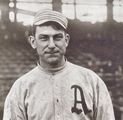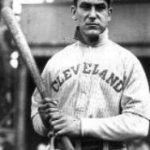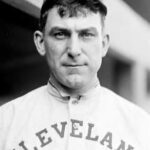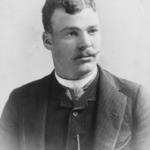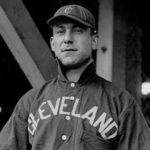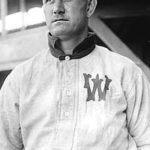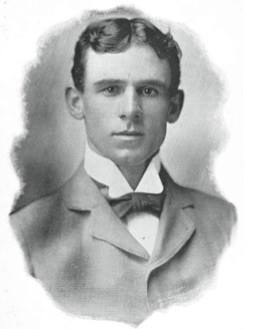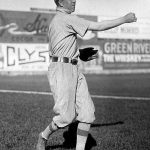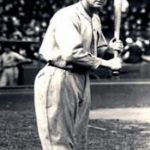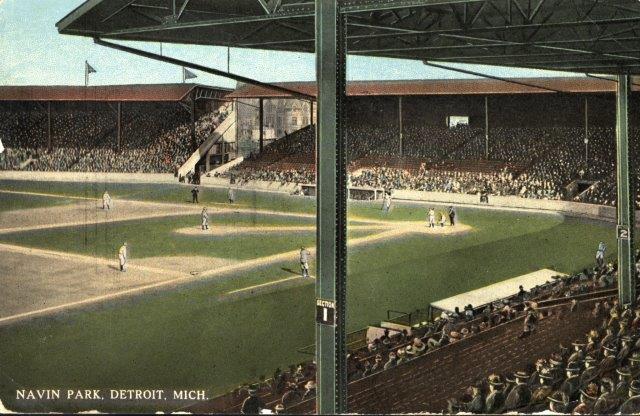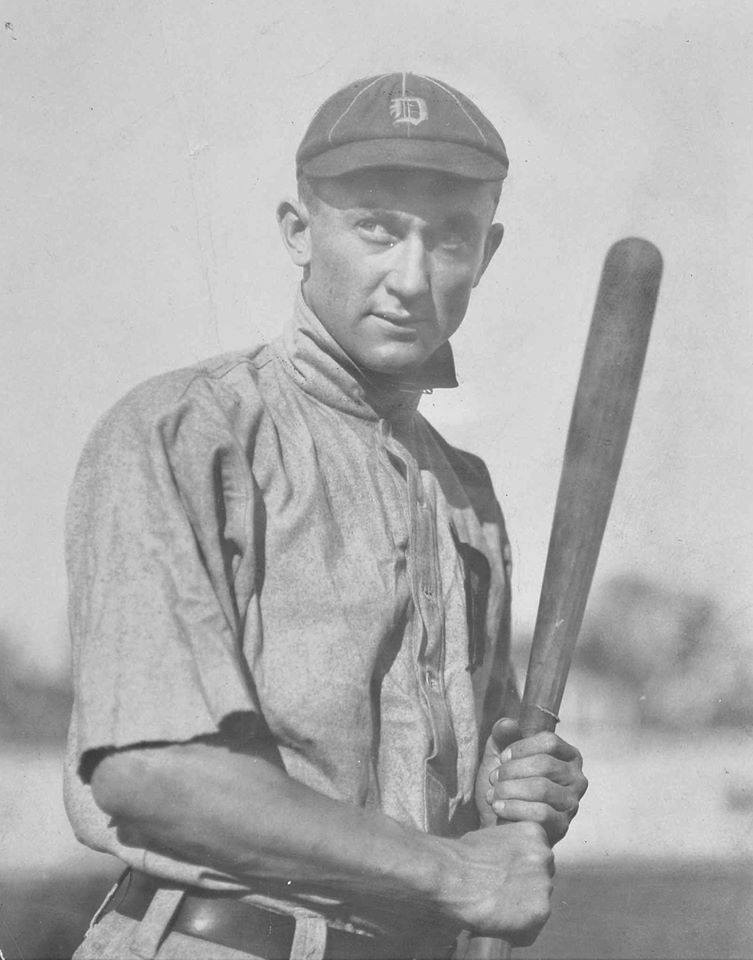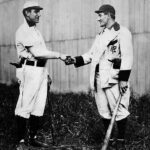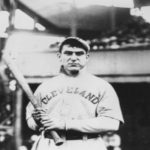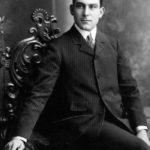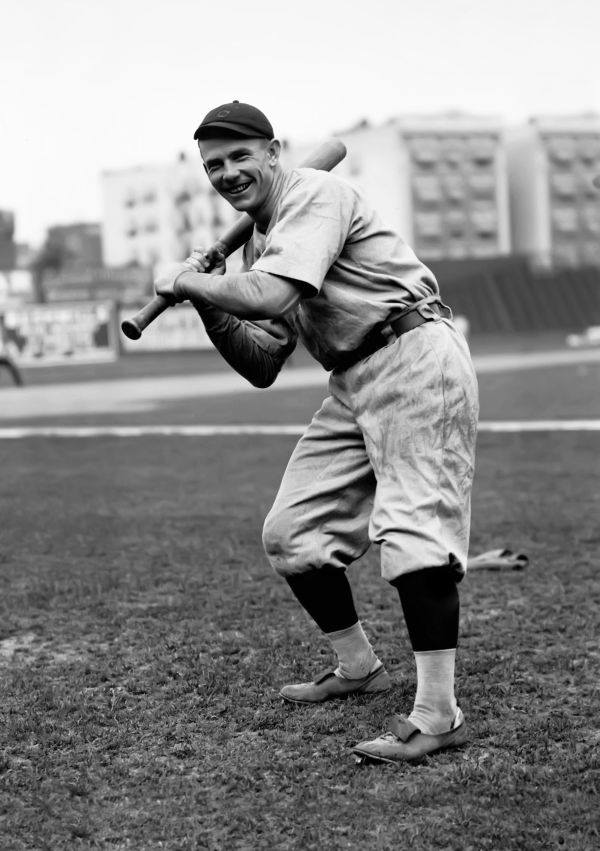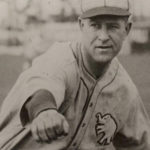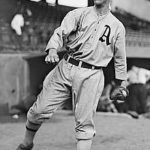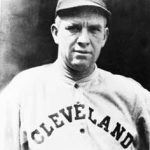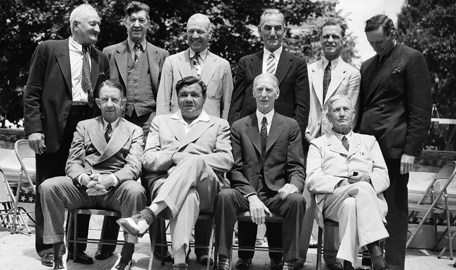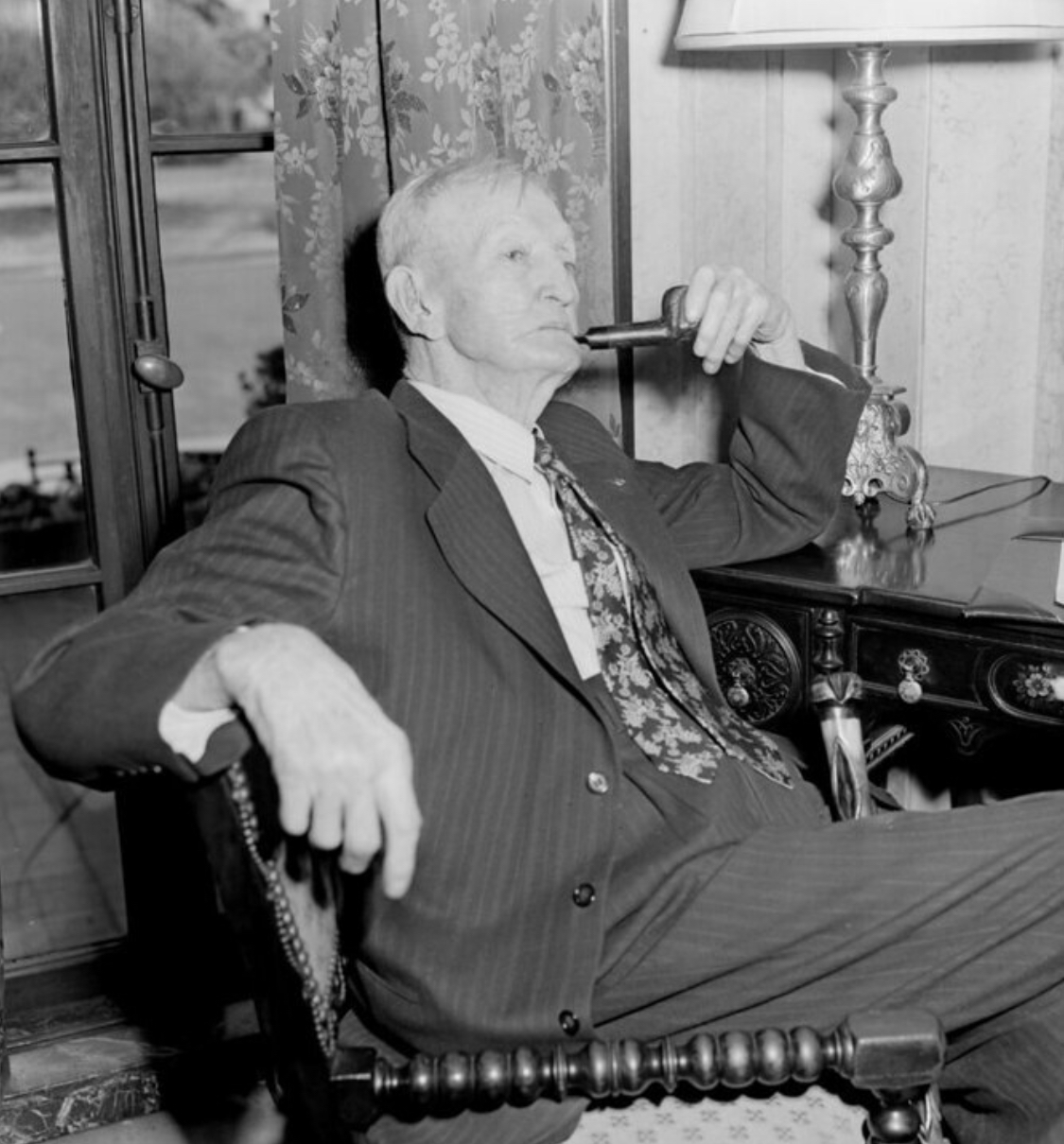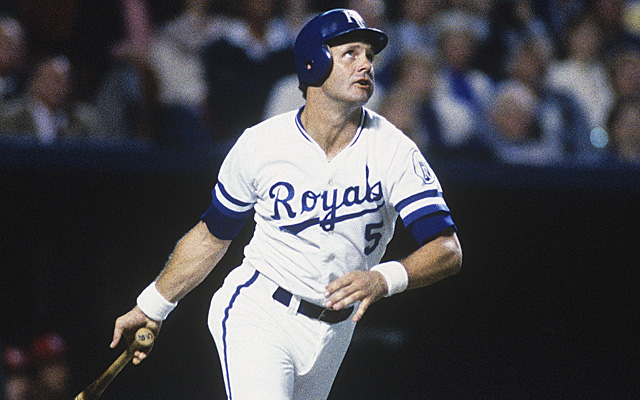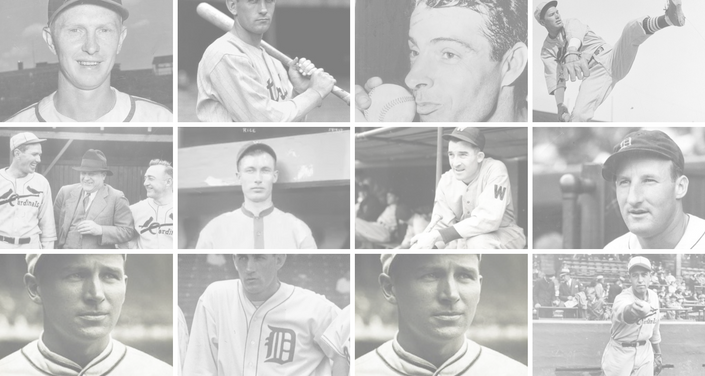Nap Lajoie
Positions: Second Baseman and First Baseman
Bats: Right • Throws: Right
6-1, 195lb (185cm, 88kg)
Born: September 5, 1874 in Woonsocket, RI
Died: February 7, 1959 (Aged 84-155d) in Daytona Beach, FL
Buried: Daytona Memorial Park, Daytona Beach, FL
Debut: August 12, 1896 (Age 21-342d, 1,964th in major league history)
Last Game: August 26, 1916 (Age 41-356d)
vs. CLE 3 AB, 1 H, 0 HR, 0 RBI, 0 SB
Hall of Fame: Inducted as Player in 1937. (Voted by BBWAA on 168/201 ballots)
Induction ceremony in Cooperstown held in 1939.
View Nap Lajoie’s Page at the Baseball Hall of Fame (plaque, photos, videos).
Full Name: Napoleon Lajoie
Nicknames: Larry or Poli
Notable Events and Chronology for Nap Lajoie Career
Biography
The first second baseman to be enshrined in Cooperstown, Napoleon Lajoie was the American League’s dominant position player during its infancy. Lajoie was so dominant that his team named itself after him for a brief period of time. Considered to be the junior circuit’s version of Honus Wagner, the second baseman rivaled the Pittsburgh Pirate immortal as baseball’s greatest defensive infielder and offensive performer throughout much of the first decade of the 20th century. Lajoie captured the American League triple crown in its inaugural season, establishing in the process the modern single-season record for highest batting average (.426). He also won four other batting titles during his career, including one of an extremely controversial nature he owed largely to his tremendous popularity.
Napoleon Lajoie was born on September 5, 1874 in Woonsocket, Rhode Island, the youngest of eight children to French-Canadian parents. Raised by his mother because his father died when he was only five, Lajoie worked in the cotton mills around Woonsocket as a youngster, developing an interest in baseball by the time he turned 10 years of age. Lajoie’s childhood idols included baseball pioneers Mike “King” Kelly, Old Hoss Radbourn, John Montgomery Ward, and John Clarkson.
After playing semi-pro ball in Rhode Island in 1895, Lajoie joined the Fall River team in the New England League the following year. Performing mostly as an outfielder, Lajoie was so successful during his three-month stint in the minors that the team sold him to the National League’s Philadelphia Phillies. The 6’1″, 195-pound Lajoie played first base for Philadelphia in the team’s final 39 games of the 1896 campaign, accumulating 57 hits and batting .326. Although he occasionally played the outfield the following year, Lajoie remained Philadelphia’s regular first baseman, batting .361, finishing among the league leaders with nine home runs, 127 runs batted in, 107 runs scored, 23 triples, and 40 doubles, and topping the circuit with 310 total bases and a .569 slugging percentage.
Lajoie moved to second base in 1898, a position he manned the remainder of his career. Although he played somewhat erratically in the field at times in his first year as a second sacker, Lajoie continued his onslaught on National League pitching, batting .324, scoring 113 runs, and leading the league with 127 runs batted in and 43 doubles.
Injuries cut into Lajoie’s playing time in both 1899 and 1900, but he still managed to post batting averages of .378 and .337 those two seasons. With the formation of the American League in 1901, Lajoie decided to jump to the crosstown Philadelphia Athletics after team owner and manager Connie Mack offered him a contract that nearly tripled the annual salary he received from the Phillies. Lajoie had a year to remember in the fledgling league’s inaugural campaign, topping the circuit in nine different offensive categories, including home runs (14), runs batted in (125), runs scored (145), hits (232), doubles (48), and batting average (.426). Lajoie’s mark of .426 remains the highest single-season batting average attained by any player since 1900.
Prior to the start of the 1902 season, the Phillies obtained a court injunction that prohibited Lajoie from appearing in a game in Philadelphia for any other team than the Phillies. After the injunction went into effect, Mack decided it would be in the best interests of everyone involved to deal Lajoie to the struggling Cleveland Bluebirds. The legal wrangling limited Lajoie to just 87 games and 352 official at-bats in 1902.
Nevertheless, he captured his second consecutive batting title, finishing the year with a mark of .378 and resuscitating the moribund Cleveland franchise, which subsequently changed its name to the “Naps” at season’s end. (The team later changed its name to the
“Indians”).
His legal troubles behind him, Lajoie won his third and fourth straight batting titles in 1903 and 1904, posting averages of .344 and .376, respectively. He was particularly productive in the second of those two seasons, also leading the league with 102 runs batted in, 208 hits, 49 doubles, a .413 on-base percentage, and a .546 slugging percentage.
A large part of Lajoie’s success can be attributed to the specially designed bat he used. Featuring two knobs, one of which was partway up the handle, it enabled Lajoie to employ a split-handed grip which offered him superior bat control. As a result, he was usually able to place the ball where he wanted.
Still, Lajoie’s slugging ability must not be overlooked. He reputedly hit the ball as hard as anyone in the game during his playing days. Hall of Fame pitcher Cy Young stated, “Lajoie was one of the most rugged hitters I ever faced. He’d take your leg off with a line drive, turn the third baseman around like a swinging door and powder the hand of the left fielder.”
Lajoie was more than just a great hitter, though. He was also an exceptional fielder and a surprisingly good baserunner, despite his lack of great running speed. Lajoie stole 380 bases during his career, surpassing 20 thefts in a season a total of 10 times. He also led all league second basemen in fielding percentage on six separate occasions. In discussing Lajoie’s defense, fellow infielder Tommy Leach gushed, “What a ballplayer that man was. Every play he made he executed so gracefully that it looked like it was the easiest thing in the world.”
After being named Cleveland’s player/manager prior to the start of the 1905 season, Lajoie was limited to only 65 games when he suffered a spike wound early in the year that caused him to develop blood poisoning and nearly took his life. Back in top form the following year, Lajoie finished 1906 with a .355 batting average and a league-leading 214 hits and 48 doubles. Although he remained baseball’s top second baseman the next three years, Lajoie’s offensive performance slipped somewhat, as he failed to bat any higher than .324 or knock in more than 74 runs. Lajoie was at his best again, though, in 1910, a season during which he and Ty Cobb battled right down to the wire for the highly-disputed league batting championship.
Prior to the start of that 1910 campaign, baseball fan Hugh Chalmers, who was President and General Manager of the Chalmers Motor Company, announced that he would present one of his company’s automobiles to the major league player who compiled the highest batting average. As it turned out, Cobb and Lajoie entered the season’s final few days as the only two players with a legitimate chance of winning the vehicle. Believing his .383 average, which was seven points higher than Lajoie’s mark of .376, virtually guaranteed him the batting championship, the unpopular Cobb elected to sit out Detroit’s final two games, leaving Lajoie the almost impossible task of raising his batting average seven points during Cleveland’s doubleheader against the St. Louis Browns.
However, St. Louis manager Jack O’Connor instructed his third baseman to play Lajoie unusually deep, enabling the popular Cleveland second baseman to bunt safely seven times and finish the season a fraction of a point ahead of Cobb in the batting race. O’Connor ended up losing his job due to his role in the alleged fix, and American League President Ban Johnson subsequently announced that a “discrepancy” had been found in the official records, and that Cobb had actually won the batting crown after all. Nevertheless, both Cobb and Lajoie received automobiles from Chalmers, and uncertainty still exists to this day as to the true winner of the batting title.
Lajoie had three more outstanding years, posting batting averages of .365, .368, and .335 in 1911, 1912, and 1913, respectively. However, age finally began to catch up to the 39-year-old second baseman in 1914, his final season in Cleveland. After batting only .258 for Cleveland that year, Lajoie rejoined Connie Mack in Philadelphia, where he spent his final two seasons before retiring at the conclusion of the 1916 campaign. Lajoie ended his career with a .338 batting average, 1,599 runs batted in, 1,504 runs scored, 3,242 hits, and 657 doubles. Only five players in baseball history have compiled more doubles. In addition to his five batting titles, Lajoie led his league in doubles five times, hits, total bases, and slugging percentage four times each, runs batted in three times, on-base percentage twice, and home runs and runs scored once each. He batted over .350 nine times, topping the .300-mark in 16 of his first 18 seasons. He also surpassed 100 runs batted in and 200 hits four times each, and he topped 40 doubles on seven separate occasions.
Lajoie was among the second group of players elected to the Hall of Fame in 1937, being inducted when the Hall first opened in 1939. He died 20 years later, at the age of 84, in Daytona Beach Florida.
Other Resources & Links
View Player Info from the B-R Bullpen
View Player Bio from the SABR BioProject



